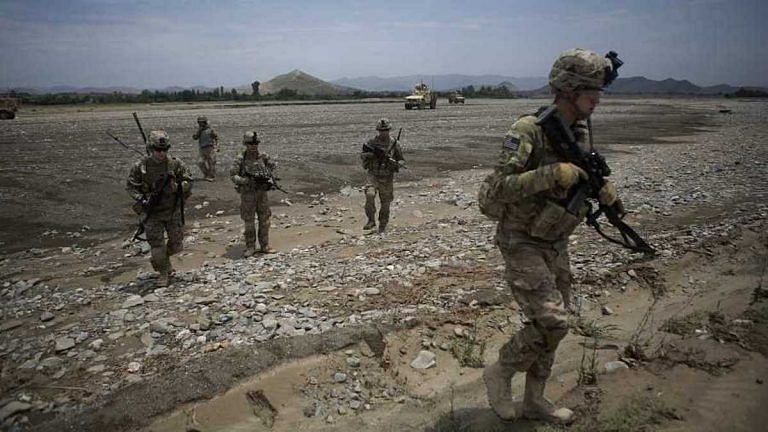New Delhi: With the US carrying out two drone strikes in Afghanistan last week, targeting alleged Islamic State Khorasan Province (ISKP) cadres, questions remain on where the American armed unmanned aerial vehicles (UAVs) are operating from.
As the Taliban have taken control of all military bases in Afghanistan, including those used by the US, sources in the Indian defence and security establishment as well as foreign analysts suspect Pakistan’s tacit support to the American drone strikes against ISKP, a known Taliban nemesis.
There is still no confirmation on the exact base which the drones are operating from.
Pakistan has officially said it “will absolutely not allow the CIA to use bases on its soil for cross-border counterterrorism missions after American forces withdraw from Afghanistan”. In an interview to media outlet Axios, Pakistan PM Imran Khan said in June that Pakistan “will not allow the CIA or US special forces to base themselves inside his country ever again”.
According to the sources, even if the drones are not operating from Pakistan, they would have to fly through its airspace to reach Afghanistan. The only alternative is Iran, they added, and noted that Tehran’s support for US operations is as good as out of the question.
The drone strikes reportedly employed the MQ-9 Reaper, an armed American drone that can carry up to eight air-to-ground 114 Hellfire missiles. The drones are controlled from Nevada, Las Vegas. However, to carry out strikes in Afghanistan, they would require a base in the vicinity to operate from.
The Reapers can be taken apart and the entire system transported anywhere in the world in the C-130 Hercules or larger aircraft.
Speculation about their take-off location centres on Qatar, Oman, the UAE or Pakistan.
The al-Udeid Air Base in Qatar, for one, is the headquarters of US Central Command Forward, US Air Force Central Command Forward, and US Special Operations Command Central Command Forward.
However, all things considered, the sources said Pakistan appears to be the closest bet.
In May, Pakistani newspaper Dawn had, quoting a US official, reported that Pakistan will continue giving air and ground access for American operations.
Also read: Islamabad has a problem. Taliban won’t tone down now – in Afghanistan or Pakistan
‘Don’t go by what Pakistan says officially’
The missiles fired from the Reapers, the sources said, have a maximum stand-off range of 20 km in the best-case scenario.
“This means that the American armed drone has to operate from near the target unlike other larger missiles, which can be fired from long stand-off ranges from a fighter or even a ship,” a source said.
Even though Pakistan Prime Minister Imran Khan has said he will not allow Americans on Pakistani bases, the US could still be using them in a secret arrangement, the sources added.
“No country is going to admit that they are giving bases for Americans to operate. So, don’t go by what Pakistan is saying officially,” a second source said. “There are multiple secret arrangements that are made. Pakistan is all about three As — Allah, Army, America. They always find their way.”
The most likely locations, the sources said, are the air fields at Shamsi and Zhob in Balochistan and the Jacobabad base in Sindh.
A third source said that even if a drone takes off from Qatar or Oman, both places where the Americans have exclusive military bases, they would still have to fly into Pakistani air space to reach Afghanistan.
Flying over Pakistan constitutes a longer route than the aerial distance between Qatar and Afghanistan via Iran, which is about 1,900 km, the sources noted.
“There are two options when flying out from Qatar. The shortest one is to fly over Iran and reach Afghanistan. However, Iranians will not allow [that] and Americans won’t take the risk because these drones can be spotted through radars and be brought down,” the third source said. “The other option is to come down the Persian Gulf, enter the Arabian Sea and travel through Pakistan air space to hit the target.”
The MQ-9, according to the US Air Force, has been modified for extended range operations through the addition of external fuel tanks capable of holding 1,300 lbs of fuel.
Although the Reapers have an endurance of more than 35 hours of flying, they fly at a very low speed of less than 200 knots (370 km/hour). The drones cannot travel very long distances at high speed and full load.
In light of this, the sources said, there need to be arrangements in place for possible emergency landings in case of any mid-air complications.
“The fact is that Pakistan directly or indirectly continues to help in drone strikes. Since these strikes are not targeted at Taliban but at the ISKP, it becomes easier for the Pakistanis and the Taliban to turn a blind eye,” a fourth source said.
The US is also reportedly in talks with central Asian countries as a potential launchpad for their counter-terrorism operations in Afghanistan.
(Edited by Sunanda Ranjan)
Also read: Return of Taliban is biggest trauma for new generation of Afghans: Amrullah Saleh’s daughter
